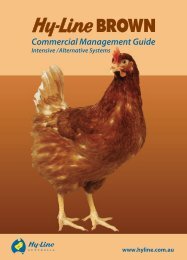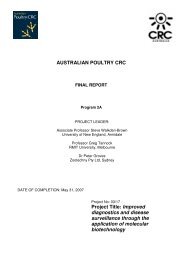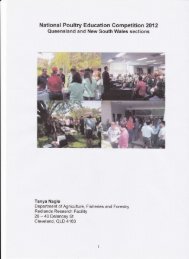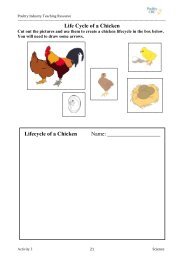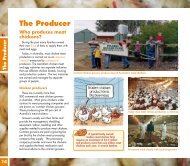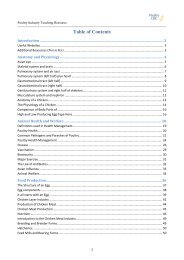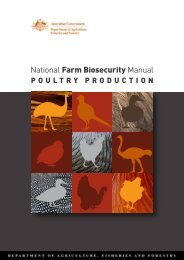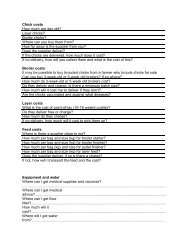You also want an ePaper? Increase the reach of your titles
YUMPU automatically turns print PDFs into web optimized ePapers that Google loves.
2.6.6 Digestibility of nutrientsApparent ileal digestibilities of protein, fat, starch and DM and the AME as a proportion of the grossenergy of feed were estimated from the analyses of feeds, freeze-dried ileal digesta and excreta; anindigestible acid-insoluble marker was used to calculate digestibilities. Diets and ileal digesta wereanalysed for DM, protein, fat and starch as described below. The apparent ileal digestibility of protein,fat, starch and DM were calculated using the following formula. All values are expressed on a DMbasis.Digestibil itydigesta nutrient ( g / kg)digesta AIA ( g / kg) ( 1) 100diet nutrient ( g / kg)diet AIA ( g / kg)where AIA is acid insoluble ash in diet or digesta.2.6.7 Proximate analysisThe dry matter content was determined gravimetrically according to the Association of OfficialAnalytical Chemists Official Method 934.01 (AOAC, 2002) as described in Section 3.2.2.1.The total starch content of the diets and ileal digesta was determined using the Megazyme Total StarchAssay Kit (Megazyme Australia Pty. Ltd., Warriewood, NSW, Australia) based on the methoddeveloped by McCleary et al. (1994). Diets and ileal digesta were analysed for protein by the methodof Sweeney (1989) using a LECO® FP-2000 automatic nitrogen analyser (Leco Corp., St. Joseph, MI,USA). The crude fat content of the ileal digesta samples was determined gravimetrically by theSoxhlet extraction procedure using Association of the Official Analytical Chemists Official Method920.39 (AOAC, 2002).2.6.8 Gut histomorphologyFormalin-fixed tissue slices from the ileum, each 5 to 6 mm thick, were enclosed in tissue cassettes(Bayer Diagnostics Australia Pty Ltd., Pymble, NSW, Australia). The tissues were processed over 19h in an automatic tissue processor (TOSCO, Thomas Optical & Scientific Co., Melbourne, Australia),and embedded in paraffin using a Histo Embedding Centre (Leica EG 1160, Leica Microsystems,Bensheim, Germany). Processing consisted of serial dehydration with ethanol, clearing with xylol andimpregnation with paraplast (wax). Embedded samples were subsequently sectioned at a thickness of 5μm with a Rotary Microtome (Leitz 1516, Leica Microsystems, Bensheim, Germany). The tissuesections on the slides were stained using Harris‟s hematoxylin (Gerorge Gurr Ltd., London, UK), andeosin (Gur Certistain, VWR International Ltd., Poole, UK), and mounted with DPX mountant(Distrene Polystyrene Xylene), for histology (BDH Laboratory Supplies, Poole, UK). Slides wereviewed on a Leica DM LB microscope (Leica Microscope GmbH, Wetzlar, Germany) andmorphometric indices were determined using computer-aided light microscope image processinganalysis system (SPOT 3.1, Diagnostic Instruments, Inc., Sterlin Heigths, MI, USA) as described byIji et al. (2001).2.6.9 Enumeration of intestinal bacteriaSamples in pre-reduced salt medium were homogenized for 2 min in CO 2 -flushed plastic bags using aMiniMix® bag mixer (Interscience, St. Nom, France) and serially diluted in 10-fold increments in prereducedsalt medium according to the technique of Miller and Wolin (1974). An aliquot (100 μL) wasplated on the appropriate agar media, for enumeration of different species.For the enumeration of bifidobacteria, the diluted samples were plated on modified tryptoneneutralizedsoy peptone-yeast extract agar (MTPY) (Petr & Rada, 2001), and incubated at 39˚C for 3days in the anaerobic cabinet. The TPY agar was supplemented with mupirocin (100 mg/mL) and16



